Dhruba Ghosh
DataComp-LM: In search of the next generation of training sets for language models
Jun 18, 2024



Abstract:We introduce DataComp for Language Models (DCLM), a testbed for controlled dataset experiments with the goal of improving language models. As part of DCLM, we provide a standardized corpus of 240T tokens extracted from Common Crawl, effective pretraining recipes based on the OpenLM framework, and a broad suite of 53 downstream evaluations. Participants in the DCLM benchmark can experiment with data curation strategies such as deduplication, filtering, and data mixing at model scales ranging from 412M to 7B parameters. As a baseline for DCLM, we conduct extensive experiments and find that model-based filtering is key to assembling a high-quality training set. The resulting dataset, DCLM-Baseline enables training a 7B parameter language model from scratch to 64% 5-shot accuracy on MMLU with 2.6T training tokens. Compared to MAP-Neo, the previous state-of-the-art in open-data language models, DCLM-Baseline represents a 6.6 percentage point improvement on MMLU while being trained with 40% less compute. Our baseline model is also comparable to Mistral-7B-v0.3 and Llama 3 8B on MMLU (63% & 66%), and performs similarly on an average of 53 natural language understanding tasks while being trained with 6.6x less compute than Llama 3 8B. Our results highlight the importance of dataset design for training language models and offer a starting point for further research on data curation.
Why are Visually-Grounded Language Models Bad at Image Classification?
May 28, 2024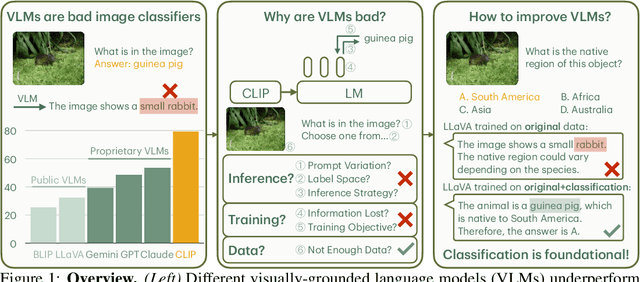
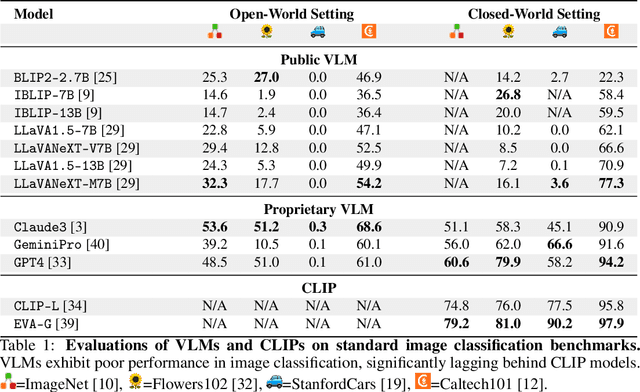
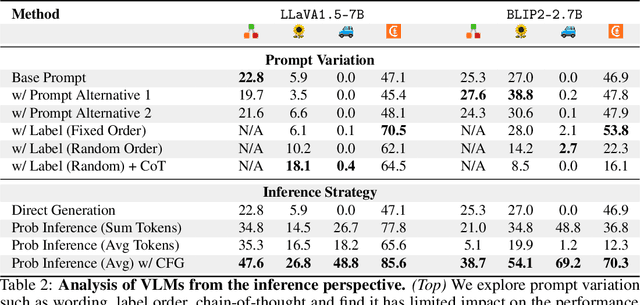

Abstract:Image classification is one of the most fundamental capabilities of machine vision intelligence. In this work, we revisit the image classification task using visually-grounded language models (VLMs) such as GPT-4V and LLaVA. We find that existing proprietary and public VLMs, despite often using CLIP as a vision encoder and having many more parameters, significantly underperform CLIP on standard image classification benchmarks like ImageNet. To understand the reason, we explore several hypotheses concerning the inference algorithms, training objectives, and data processing in VLMs. Our analysis reveals that the primary cause is data-related: critical information for image classification is encoded in the VLM's latent space but can only be effectively decoded with enough training data. Specifically, there is a strong correlation between the frequency of class exposure during VLM training and instruction-tuning and the VLM's performance in those classes; when trained with sufficient data, VLMs can match the accuracy of state-of-the-art classification models. Based on these findings, we enhance a VLM by integrating classification-focused datasets into its training, and demonstrate that the enhanced classification performance of the VLM transfers to its general capabilities, resulting in an improvement of 11.8% on the newly collected ImageWikiQA dataset.
Getting it Right: Improving Spatial Consistency in Text-to-Image Models
Apr 01, 2024Abstract:One of the key shortcomings in current text-to-image (T2I) models is their inability to consistently generate images which faithfully follow the spatial relationships specified in the text prompt. In this paper, we offer a comprehensive investigation of this limitation, while also developing datasets and methods that achieve state-of-the-art performance. First, we find that current vision-language datasets do not represent spatial relationships well enough; to alleviate this bottleneck, we create SPRIGHT, the first spatially-focused, large scale dataset, by re-captioning 6 million images from 4 widely used vision datasets. Through a 3-fold evaluation and analysis pipeline, we find that SPRIGHT largely improves upon existing datasets in capturing spatial relationships. To demonstrate its efficacy, we leverage only ~0.25% of SPRIGHT and achieve a 22% improvement in generating spatially accurate images while also improving the FID and CMMD scores. Secondly, we find that training on images containing a large number of objects results in substantial improvements in spatial consistency. Notably, we attain state-of-the-art on T2I-CompBench with a spatial score of 0.2133, by fine-tuning on <500 images. Finally, through a set of controlled experiments and ablations, we document multiple findings that we believe will enhance the understanding of factors that affect spatial consistency in text-to-image models. We publicly release our dataset and model to foster further research in this area.
GenEval: An Object-Focused Framework for Evaluating Text-to-Image Alignment
Oct 17, 2023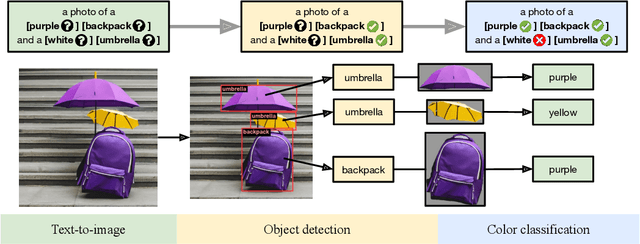
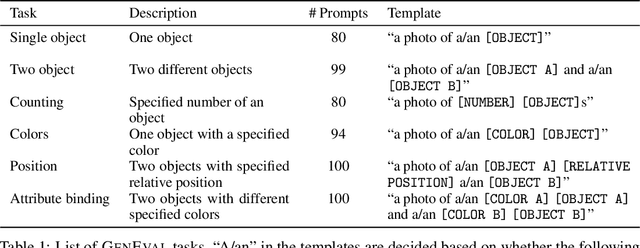
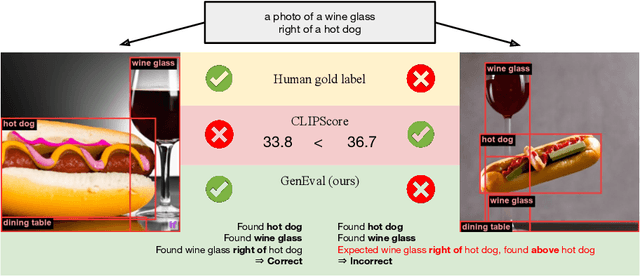

Abstract:Recent breakthroughs in diffusion models, multimodal pretraining, and efficient finetuning have led to an explosion of text-to-image generative models. Given human evaluation is expensive and difficult to scale, automated methods are critical for evaluating the increasingly large number of new models. However, most current automated evaluation metrics like FID or CLIPScore only offer a holistic measure of image quality or image-text alignment, and are unsuited for fine-grained or instance-level analysis. In this paper, we introduce GenEval, an object-focused framework to evaluate compositional image properties such as object co-occurrence, position, count, and color. We show that current object detection models can be leveraged to evaluate text-to-image models on a variety of generation tasks with strong human agreement, and that other discriminative vision models can be linked to this pipeline to further verify properties like object color. We then evaluate several open-source text-to-image models and analyze their relative generative capabilities on our benchmark. We find that recent models demonstrate significant improvement on these tasks, though they are still lacking in complex capabilities such as spatial relations and attribute binding. Finally, we demonstrate how GenEval might be used to help discover existing failure modes, in order to inform development of the next generation of text-to-image models. Our code to run the GenEval framework is publicly available at https://github.com/djghosh13/geneval.
DataComp: In search of the next generation of multimodal datasets
May 03, 2023Abstract:Large multimodal datasets have been instrumental in recent breakthroughs such as CLIP, Stable Diffusion, and GPT-4. At the same time, datasets rarely receive the same research attention as model architectures or training algorithms. To address this shortcoming in the machine learning ecosystem, we introduce DataComp, a benchmark where the training code is fixed and researchers innovate by proposing new training sets. We provide a testbed for dataset experiments centered around a new candidate pool of 12.8B image-text pairs from Common Crawl. Participants in our benchmark design new filtering techniques or curate new data sources and then evaluate their new dataset by running our standardized CLIP training code and testing on 38 downstream test sets. Our benchmark consists of multiple scales, with four candidate pool sizes and associated compute budgets ranging from 12.8M to 12.8B samples seen during training. This multi-scale design facilitates the study of scaling trends and makes the benchmark accessible to researchers with varying resources. Our baseline experiments show that the DataComp workflow is a promising way of improving multimodal datasets. We introduce DataComp-1B, a dataset created by applying a simple filtering algorithm to the 12.8B candidate pool. The resulting 1.4B subset enables training a CLIP ViT-L/14 from scratch to 79.2% zero-shot accuracy on ImageNet. Our new ViT-L/14 model outperforms a larger ViT-g/14 trained on LAION-2B by 0.7 percentage points while requiring 9x less training compute. We also outperform OpenAI's CLIP ViT-L/14 by 3.7 percentage points, which is trained with the same compute budget as our model. These gains highlight the potential for improving model performance by carefully curating training sets. We view DataComp-1B as only the first step and hope that DataComp paves the way toward the next generation of multimodal datasets.
The Effect of Model Size on Worst-Group Generalization
Dec 08, 2021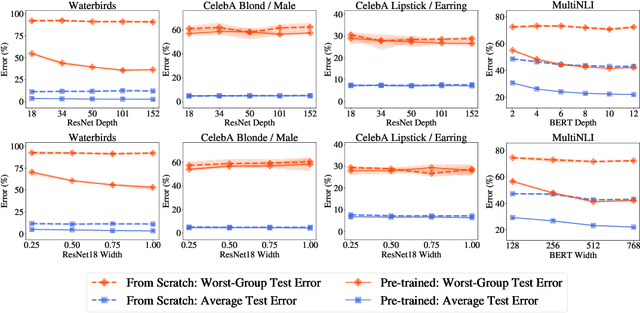

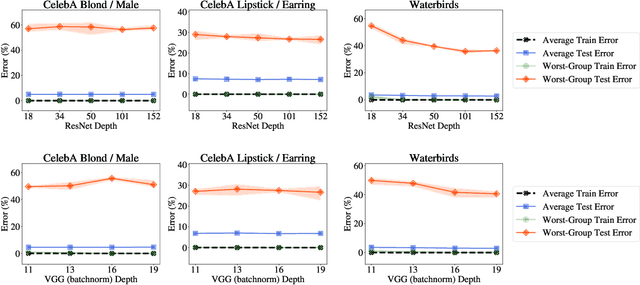

Abstract:Overparameterization is shown to result in poor test accuracy on rare subgroups under a variety of settings where subgroup information is known. To gain a more complete picture, we consider the case where subgroup information is unknown. We investigate the effect of model size on worst-group generalization under empirical risk minimization (ERM) across a wide range of settings, varying: 1) architectures (ResNet, VGG, or BERT), 2) domains (vision or natural language processing), 3) model size (width or depth), and 4) initialization (with pre-trained or random weights). Our systematic evaluation reveals that increasing model size does not hurt, and may help, worst-group test performance under ERM across all setups. In particular, increasing pre-trained model size consistently improves performance on Waterbirds and MultiNLI. We advise practitioners to use larger pre-trained models when subgroup labels are unknown.
Are Larger Pretrained Language Models Uniformly Better? Comparing Performance at the Instance Level
May 13, 2021
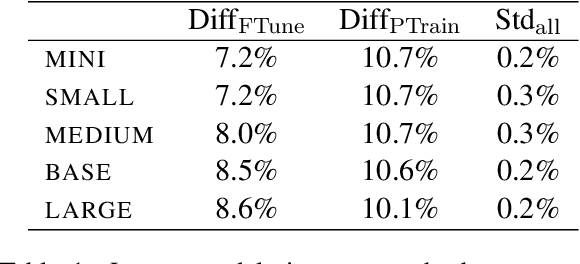


Abstract:Larger language models have higher accuracy on average, but are they better on every single instance (datapoint)? Some work suggests larger models have higher out-of-distribution robustness, while other work suggests they have lower accuracy on rare subgroups. To understand these differences, we investigate these models at the level of individual instances. However, one major challenge is that individual predictions are highly sensitive to noise in the randomness in training. We develop statistically rigorous methods to address this, and after accounting for pretraining and finetuning noise, we find that our BERT-Large is worse than BERT-Mini on at least 1-4% of instances across MNLI, SST-2, and QQP, compared to the overall accuracy improvement of 2-10%. We also find that finetuning noise increases with model size and that instance-level accuracy has momentum: improvement from BERT-Mini to BERT-Medium correlates with improvement from BERT-Medium to BERT-Large. Our findings suggest that instance-level predictions provide a rich source of information; we therefore, recommend that researchers supplement model weights with model predictions.
 Add to Chrome
Add to Chrome Add to Firefox
Add to Firefox Add to Edge
Add to Edge